Articles
“It Was Always Great With Gil” Homage To Clancy….BORGES

 There used to be a sign on the wall of the old gym on West 28th Street in lower Manhattan that illustrated the kind of guy Gil Clancy was.
There used to be a sign on the wall of the old gym on West 28th Street in lower Manhattan that illustrated the kind of guy Gil Clancy was.
It read: “PLEASE DON’T BE AFRAID TO THROW GARBAGE IN WASTE BIN.’
Nobody knew for sure if Clancy put it there or not. It could have been his long-time partner, Howie Albert. It could have been the guy who owned the place. But most likely it was Clancy because that’s the kind of double-edged wit he had.
That’s not what made him one of boxing’s greatest trainers and managers. He had other skills for that. But it’s what made him one of the grand guys in boxing.
Gil Clancy could tell a story, pull your leg and teach you something new with equal alacrity. When he was done you were usually smiling and always had more understanding of the situation than you did before.
The light went out in Clancy’s eyes Thursday morning at an assisted living facility in Lynbrook, N.Y., out on the island only miles from where he grew up in Queens. Boxing is a lesser place today for it but a greater place for having had him in its midst for so long.
It’s not a sadder place because at 88 Gil Clancy lived a full life, packing more into his time here than anyone could ever hope for. Yet there’s a hole in boxing now that no one is going to fill.
They don’t make many trainers like Gil Clancy any more, guys who are teachers and not just someone who bought a towel and walked into a gym claiming he was a trainer. He was a teacher by trade, the owner of a Master’s degree in education from NYU, and he had a former Phys. Ed teacher’s eye for developing a young athlete into whatever the best of him could be.
A successful amateur boxer in college and the Army, Clancy came home to New York and began working as a teacher by day and a trainer at a PAL gym in Queens at night in the 1950s. As these things often do, one kid led to another and next thing you knew he had a pupil named Ralph “Tiger’’ Jones and his Phys. Ed days were behind him.
Jones never became a champion but he beat a few, including Sugar Ray Robinson, Kid Gavilan and Joey Giardello. He became a regular on televised boxing in the ‘50s and always standing behind him was Clancy, who by the time he’d left the corner for the broadcast booth 30 some odd years later had put together a Hall of Fame career.
He worked with Muhammad Ali, Jerry Quarry, Ken Buchanan, Joe Frazier, George Foreman, Gerry Cooney and came out of retirement to help Oscar De La Hoya learn his trade but he was most remembered for two guys – Rodrigo Valdes and Emile Griffith, great fighters both.
Griffith was perhaps his finest student, a kid he found in a factory who became welterweight and middleweight champion during a 20-year career. He started with Clancy and he ended with him and decades later, when they were both fighting old age. They would go together to the International Hall of Fame induction each June, two old friends who once had shared a dream and lived it.
Clancy was a realist and a funny one. Asked once, by a young sportswriter trying to figure out the odd angles of boxing, why a particularly inept fighter stuck with the sport Clancy smiled at what the young man didn’t know and enlightened him in a sentence.
“He’s a fighter because he’s too lazy to go to work,’’ Clancy growled. Then he smiled. He knew he was right. Years later, the writer understood.
Clancy led Griffith through some of the darkest times a boxer can face after he’d beaten Benny Paret to death. It is believed to be the first time a death in the ring was nationally televised and when it happened again a year later boxing all but disappeared from the small screen until 1970.
It was the third fight between them and Paret had what Griffith wanted, the welterweight title. Paret nearly knocked Griffith out in the sixth round that dark night of March 24, 1962, but Clancy told him in the corner what to expect the next round and to stay close to Paret and throw punches on the inside to keep him off and keep referee Ruby Goldstein conscious of the fact he was fighting back.
By the 12th round the roles had reversed and after getting Paret in trouble Griffith hit him 18 times in six seconds as the already unconscious champion squatted in the corner, one arm trapped behind the turnbuckle so he couldn’t fall. By the time Goldstein got between them, Paret had slumped toward the floor, the life leaking out of him.
In a sense he took Griffith with him. Although he would fight on and even win the middleweight title Griffith was never a finisher after that and Clancy knew it. He also knew why and so, like any great teacher, he worked with what he had rather than demanding from Griffith that which he could not give.
That was the kind of keen eye Clancy had and the kind of understanding a great trainer needs. You don’t train Joe Frazier and Rodrigo Valdez the same way. Clancy innately knew that but he also possessed a vast storehouse of knowledge about the small things that make a fighter dangerous and he could pass that on better than most of his fellow tradesman in the gym.
Yet Clancy was more than a trainer. He was, as Top Rank matchmaker Bruce Trampler said, “a real Renaissance man. He could do everything in the sport and do it well.’’
Twice named Manager of the Year, Clancy took over as matchmaker at Madison Square Garden for Teddy Brenner in 1977. Trampler worked with him there for three years until Clancy left in 1980 to become half of one of broadcasting’s greatest boxing teams, joining forces with Tim Ryan at CBS.
Soon Clancy had won the Sam Taub Award for excellence in boxing broadcasting, giving him a pretty clean sweep of things once he’d added his Hall of Fame ring to his trophy collection.
Often at his side was Bob Arum, who staged many of the sport’s biggest promotions with Clancy behind the microphone and, more importantly, in a restaurant somewhere in Europe.
“Gil approved fights at CBS in those days and I’d call and tell him I had Victor Galindez fighting Eddie Mustafa or something and he’d say, ‘That’s an all right fight, I guess,’’ Arum recalled with a chuckle. “Then I’d say we’re going to put it in Monte Carlo and he’d say, ‘What a great fight that’s going to be!’ We had so many great times together. We’d build a whole summer boxing schedule around the Tour de France.
“Gil was one of my dearest friends. I’m not sad because the memories he left me with will be with me forever.’’
Not all of those came in boxing. Arum and Clancy were partners in several race horses including one called Merchant of Baghdad. According to Arum, the only winner was a horse named Virginia Reel, who finally got them in the winner’s circle on a day they both laughed about for years.
“It was pouring rain at Aqueduct,’’ Arum recalled. “It was late in the day. Like the 10th race or something and Virginia whatever his name wins the race. You’d of thought we won the Kentucky Derby. We go charging down to the winner’s circle, drenched, mud in our shoes and the cuffs of our pants, to see this cockamamie horse. It was always great with Gil.’’
It was Arum who coerced Clancy out of retirement to work with young De La Hoya and his then trainer Robert Alcazar. Clancy stayed in the shadows, teaching both his pupils without making either feel like he’d rode in to save the day.
Everything worked well until the night De La Hoya was robbed of the decision in the Felix Trinidad fight and lost the right to complain because he fought the last few rounds as if they were a track meet. Later he would dismiss Clancy without ever facing him, one last disappointment in a sport that gives you plenty of them. Clancy said little about that experience, choosing instead to believe anyone who knew anything about what happened. And they did.
“I’d rate him slightly behind Eddie Futch, who I think is the greatest trainer who ever lived, but so much better than the trainers today except for Freddy Roach,’’ Arum said of Clancy. “Gil was a really great trainer. Very intelligent and he had the skills to communicate. And he was great in the corner.
“He was a sensational broadcaster too. He and Tim Ryan made a great, great team. And he was a handsome SOB. He had to fight the women off.
“I remember once we were at a fight and a stripper named Edy Williams (who made soft porn movies in the ‘70s and ran naked into the ring in New Orleans when Ali fought a rematch with Leon Spinks) was after him. She was crazy for Gil. She’s chasing him one night, ‘Gil! Gil! I love you, Gil.’’’
If you ever heard him call a fight on CBS or saw him work the corner or, most of all, ever went up that rickety old elevator to the fifth floor of the Telestar Gym on West 28th between the button manufacturer and the fur company and paid a visit, you felt the same way.
Articles
2015 Fight of the Year – Francisco Vargas vs Takashi Miura

The WBC World Super Featherweight title bout between Francisco Vargas and Takashi Miura came on one of the biggest boxing stages of 2015, as the bout served as the HBO pay-per-view’s co-main event on November 21st, in support of Miguel Cotto vs Saul Alvarez.
Miura entered the fight with a (29-2-2) record and he was making the fifth defense of his world title, while Vargas entered the fight with an undefeated mark of (22-0-1) in what was his first world title fight. Both men had a reputation for all-out fighting, with Miura especially earning high praise for his title defense in Mexico where he defeated Sergio Thompson in a fiercely contested battle.
The fight started out hotly contested, and the intensity never let up. Vargas seemed to win the first two rounds, but by the fourth round, Miura seemed to pull ahead, scoring a knock-down and fighting with a lot of confidence. After brawling the first four rounds, Miura appeared to settle into a more technical approach. Rounds 5 and 6 saw the pendulum swing back towards Vargas, as he withstood Miura’s rush to open the fifth round and the sixth round saw both men exchanging hard punches.
The big swinging continued, and though Vargas likely edged Miura in rounds 5 and 6, Vargas’ face was cut in at least two spots and Miura started to assert himself again in rounds 7 and 8. Miura was beginning to grow in confidence while it appeared that Vargas was beginning to slow down, and Miura appeared to hurt Vargas at the end of the 8th round.
Vargas turned the tide again at the start of the ninth round, scoring a knock down with an uppercut and a straight right hand that took Miura’s legs and sent him to the canvas. Purely on instinct, Miura got back up and continued to fight, but Vargas was landing frequently and with force. Referee Tony Weeks stepped in to stop the fight at the halfway point of round 9 as Miura was sustaining a barrage of punches.
Miura still had a minute and a half to survive if he was going to get out of the round, and it was clear that he was not going to stop fighting.
A back and forth battle of wills between two world championship level fighters, Takashi Miura versus “El Bandido” Vargas wins the 2015 Fight of the Year.
WATCH RELATED VIDEOS ON BOXINGCHANNEL.TV
Articles
Jan 9 in Germany – Feigenbutz and De Carolis To Settle Score

This coming Saturday, January 9th, the stage is set at the Baden Arena in Offenburg, Germany for a re-match between Vincent Feigenbutz and Giovanni De Carolis. The highly anticipated re-match is set to air on SAT.1 in Germany, and Feigenbutz will once again be defending his GBU and interim WBA World titles at Super Middleweight.
The first meeting between the two was less than three months ago, on October 17th and that meeting saw Feigenbutz controversially edge De Carolis on the judge’s cards by scores of (115-113, 114-113 and 115-113). De Carolis scored a flash knock down in the opening round, and he appeared to outbox Feigenbutz in the early going, but the 20 year old German champion came on in the later rounds.
The first bout is described as one of the most crowd-pleasing bouts of the year in Germany, and De Carolis and many observers felt that the Italian had done enough to win.
De Carolis told German language website RAN.DE that he was more prepared for the re-match, and that due to the arrogance Feigenbutz displayed in the aftermath of the first fight, he was confident that he had won over some of the audience. Though De Carolis fell short of predicting victory, he promised a re-vamped strategy tailored to what he has learned about Feigenbutz, whom he termed immature and inexperienced.
The stage is set for Feigenbutz vs De Carolis 2, this Saturday January 9th in Offenburg, Germany. If you can get to the live event do it, if not you have SAT.1 in Germany airing the fights, and The Boxing Channel right back here for full results.
Articles
2015 Knock Out of the Year – Saul Alvarez KO’s James Kirkland

On May 9th of 2015, Saul “Canelo” Alvarez delivered a resonant knock-out of James Kirkland on HBO that wins the 2015 KO of the Year.
The knock-out itself came in the third round, after slightly more than two minutes of action. The end came when Alvarez delivered a single, big right hand that caught Kirkland on the jaw and left him flat on his back after spinning to the canvas.Alvarez was clearly the big star heading into the fight. The fight was telecast by HBO for free just one week after the controversial and disappointing Floyd Mayweather Jr. and Manny Pacquiao fight, and Alvarez was under pressure to deliver the type of finish that people were going to talk about. Kirkland was happy to oblige Alvarez, taking it right to Alvarez from the start. Kirkland’s aggression saw him appear to land blows that troubled the young Mexican in the early going. Alvarez played good defense, and he floored Kirkland in the first round, displaying his power and his technique in knocking down an aggressive opponent.
However, Kirkland kept coming at Alvarez and the fight entered the third round with both men working hard and the feeling that the fight would not go the distance. Kirkland continued to move forward, keeping “Canelo” against the ropes and scoring points with a barrage of punches while looking for an opening.
At around the two minute mark, Alvarez landed an uppercut that sent Kirkland to the canvas again. Kirkland got up, but it was clear that he did not have his legs under him. Kirkland was going to try to survive the round, but Alvarez had an opportunity to close out the fight. The question was would he take it?
Alvarez closed in on Kirkland, putting his opponent’s back to the ropes. Kirkland was hurt, but he was still dangerous, pawing with punches and loading up for one big shot.
But it was the big shot “Canelo” threw that ended the night. Kirkland never saw it coming, as he was loading up with a huge right hand of his own. The right Alvarez threw cracked Kirkland in the jaw, and his eyes went blank. His big right hand whizzed harmlessly over the head of a ducking Alvarez, providing the momentum for the spin that left Kirkland prone on the canvas.
Saul “Canelo” Alvarez went on to defeat Miguel Cotto in his second fight of 2015 and he is clearly one of boxing’s biggest stars heading into 2016. On May 9th Alvarez added another reel to his highlight film when he knocked out James Kirkland with the 2015 “Knock Out of the Year”.
Photo by naoki fukuda
-
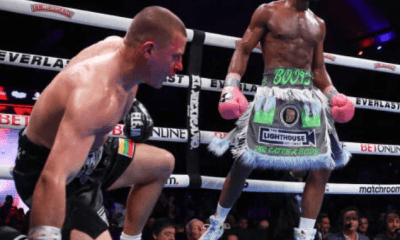
 Featured Articles4 weeks ago
Featured Articles4 weeks agoJaron ‘Boots’ Ennis Wins Welterweight Showdown in Atlantic City
-

 Featured Articles4 weeks ago
Featured Articles4 weeks agoBoxing Notes and Nuggets from Thomas Hauser
-
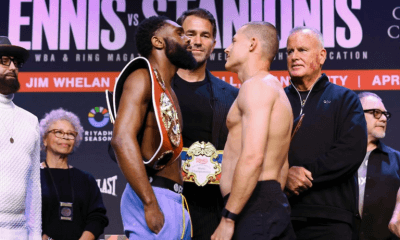
 Featured Articles4 weeks ago
Featured Articles4 weeks agoAvila Perspective Chap 320: Boots Ennis and Stanionis
-
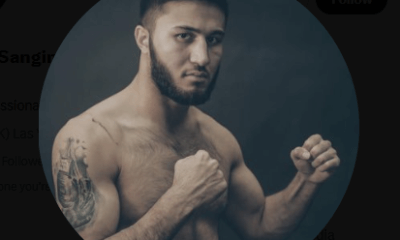
 Featured Articles4 weeks ago
Featured Articles4 weeks agoMekhrubon Sanginov, whose Heroism Nearly Proved Fatal, Returns on Saturday
-
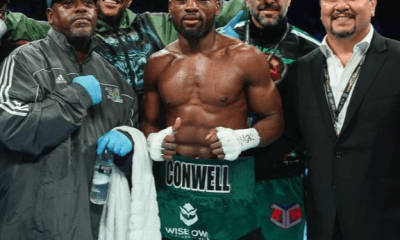
 Featured Articles3 weeks ago
Featured Articles3 weeks agoAvila Perspective, Chap. 322: Super Welterweight Week in SoCal
-
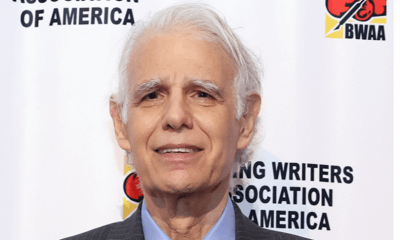
 Featured Articles4 weeks ago
Featured Articles4 weeks agoTSS Salutes Thomas Hauser and his Bernie Award Cohorts
-
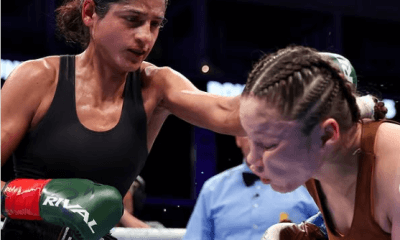
 Featured Articles3 weeks ago
Featured Articles3 weeks agoGabriela Fundora KOs Marilyn Badillo and Perez Upsets Conwell in Oceanside
-
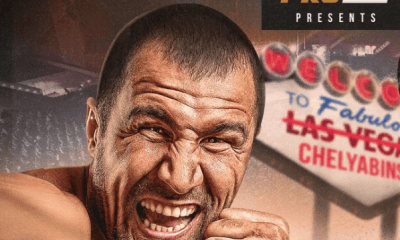
 Featured Articles3 weeks ago
Featured Articles3 weeks ago‘Krusher’ Kovalev Exits on a Winning Note: TKOs Artur Mann in his ‘Farewell Fight’

















